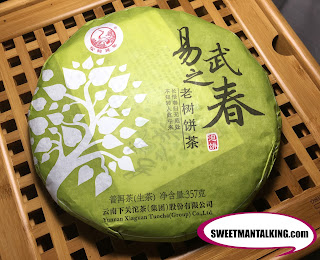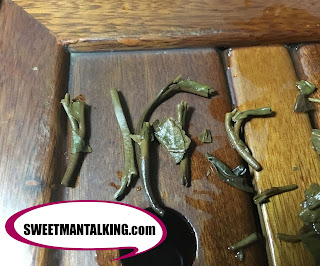This time round, i would share with everyone a tea not by its brand. But sharing it based on the region the tea leaves are grown and harvested! I will be sharing a 生普 (raw pu'erh tea leaves) that harvested in the spring of 2016 (around April). Hence what I am using for the review is considered a pretty fresh leaves (新茶) that are not even pressed into a disc (饼), bricks (砖) or semi-sphere (沱) for storage purpose... we call it loose tea (散茶).
Every year, spring (春), that is when most of the tea leaves are harvested for the various kind of tea. And of course there can be a really long write up to explain tea harvested during various part of the spring; Example tea harvested early-spring, tea harvested before-the-rain comes (雨前茶), tea-harvested before-QingMing festive (明前茶) and so on... In term of taste differences, it might not be as obvious and as big differences as its price; it is obviously more rare to have the leaves completely grown and ready to harvest earlier in the spring hence the more expensive price tag.
Today's blog, to make my sharing really straight forward, we focus only on what I going to share, I generalize the tea leaves I used as "Spring Tea" (春茶).
Today's blog, to make my sharing really straight forward, we focus only on what I going to share, I generalize the tea leaves I used as "Spring Tea" (春茶).
You might also be wondering, why i stated in the first line "review a tea not by its brand"? Again, i don't want the focus be diverted. I want to share with you tea leaves harvested at this mountain known as YiWu Mountain (易武山) and not affect people on the judgement of the tea based on brand it associated with (yes, indirectly to a lot of tea-lover, the brand do at times affect how we review a tea subconsciously due to its value is higher for a reputable brand).
Here are some background of YiWu (易武山). "YiWu" in the tribal language it means "The place where the Beautiful Lady Snakes live". It got its name from a cave located at YiWu that is filled with snakes. The YiWu Mountain Tea region (易武茶区) consist of the whole YiWu villages as well as those region under ManSa Mountain (慢撒茶山). The region with more of those ancient trees are the Yiwu (易武)、MaHe(麻黑)、LuoShuiDong (落水洞)、GuaFengZhai (刮风寨)、LaoDingJiaZhai (老丁家寨) and ManXiu (曼秀) area.
YiWu is Yunnan's famous ancient tea cultivation region, with a long history of tea planting. As early as Tang Dynasty, already existed several tribal natives (BuLang 布朗族, Wa 佤族, HaNi 哈尼族 etc) living at YiWu while growing tea plants there. Till today, we can find traces of few hectares of land filled with old ancient trees as tall as over 20 metres. All planted by the tribal people back thousand of years ago hence the trees aged for more than thousand of years.
 |
| "YiWu's Spring" by XiaGuan (易武之春 - 下关 2015) |
 |
| YiWu Main Region - by TaeTea 易武正山-大益 2014 |
For collectors, I always strongly encouraged to go for tea product that have a strong tea base to start with. As we all know value of pu'erh increases over time as the tea leaves aged and mature, and "time" is a constant factor that multiply the value of the tea depending on the quality of the "base value" of the tea leaves. Having a good "base value" provide the value of the collection (tea) to increase exponentially over time.
Some basic characteristic of tea leaves from the YiWu Mountain...
The leaves are generally black, long shred and shiny. The colour of the tea after brewing is usually golden yellow, very little bitterness to speak of. High in fragrance, strong hint of sweetness, generally smooth and giving a great after-taste that lingers long around the palate.
 |
| YiWu's freshly spring harvested tea after 3rd washing |
The Tea leaves I trying/sharing today live up to its name indeed.
The tea leaves from YiWu region usually mature faster too. And also due to the fact that lots of these trees are reduced in height thru the years (a trimming technique some farmers practise), and that the leaves also do grow in the wild in this region, tea leaves tend to have subtle taste differences ranging from village to village within the YiWu tea region.
Take a look at the debris/leftover after the brewing...
These are the typical 一芽二叶 tea leaves (one bud and two tea leaves) combination that signal that tea leaves are the best to be harvested. If the tea leaves only showing one bud/one left, it is a bit too young to be harvested and likewise, one that showing one bud/three leaves, it is a bit too old for a nice brew.
To end the sharing/review, i would side track a little regarding drinking raw tea.... if you have a weak stomach, avoid drinking raw pu'erh tea with an empty stomach. These raw tea are high in acidity with the leaves still contains high dosage of caffeine. Some connoisseur suggest to go with some light cracker in order not to be distracted from the taste of the tea. But to me, pairing it with nice food sometimes do make tea drinking a bit more interesting and gives you some unexpected result. So be daring to try and you might discover some good pairing that brings out the better side of your tea collection? It also makes tea drinking closer to our day to day lifestyle and makes it a more sustainable hobby, don't you think so?
















